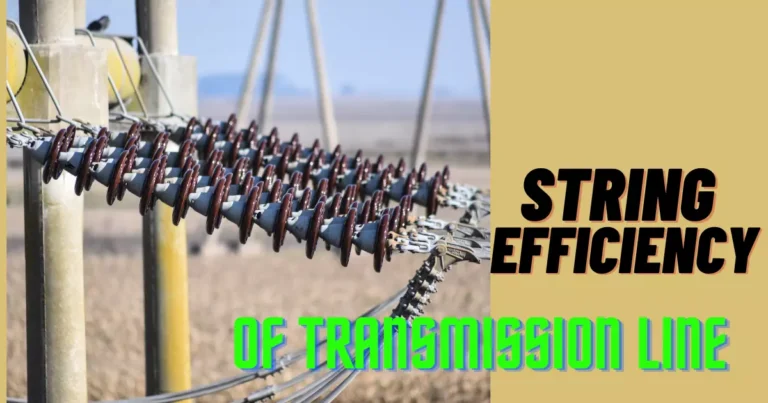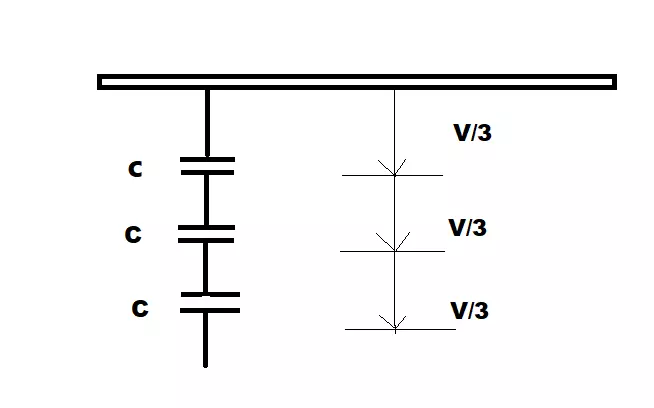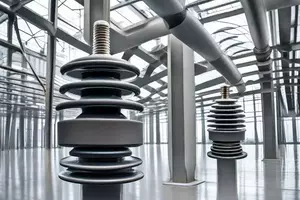In the world of electrical engineering, every component plays a crucial role in ensuring the seamless flow of electricity. One such vital component is the suspension insulator. Suspension insulators are integral to the efficient and safe transmission of electrical power over long distances. To optimize their performance and ensure minimal energy loss, it’s essential to comprehend the concept of “string efficiency.” In this comprehensive guide, we will explore String Efficiency of Suspension Insulators In Transmission Line
Article Content
ToggleSection 1: Understanding String Efficiency of Suspension Insulators In Transmission Line
1.1 What Are Suspension Insulators
Suspension insulators are a type of electrical insulator commonly used in overhead power transmission lines. They play a crucial role in supporting electrical conductors (usually made of aluminum or copper) and ensuring that these conductors are isolated from the supporting structures (such as towers or poles). The primary function of suspension insulators is to prevent the flow of electric current from the conductor to the tower or pole, which could lead to power loss, short circuits, or even accidents.

1.2 Components of Suspension Insulators
A suspension insulator typically consists of several key components:
- **Insulator Sheds**: These are usually made of ceramic material and are stacked on top of each other. Their shape and design are essential for providing electrical insulation.
- **Core Rod**: The core rod is the central part of the insulator and provides mechanical strength. It is typically made of materials like steel or composite materials.
- **End Fittings**: The end fittings are attached to the insulator to connect it to the conductor and supporting structure.
1.3 The Role of Suspension Insulators in Power Transmission
Suspension insulators are strategically placed along the transmission line to support the conductors and maintain the necessary electrical insulation. Their placement ensures that the conductors are suspended in the air, reducing the risk of contact with the supporting structures.
Section 2: String Efficiency - The Key to Optimal Performance
2.1 What Is String Efficiency?
String Efficiency Of Suspension Insulators Is A Crucial Parameter In The Design And Evaluation Of Suspension Insulator Strings. It Measures The Effectiveness Of A String Of Insulators In Isolating The Conductor From The Supporting Structure. In Other Words, String Efficiency Quantifies How Well The Insulator String Prevents Leakage Or Surface Current Along The Insulator Chain.
A High String Efficiency Of Suspension Insulators Indicates That The Insulator String Effectively Isolates The Conductor, While A Low String Efficiency Suggests That The Insulators Are Not Performing Optimally, Potentially Leading To Energy Loss And Electrical Issues.

2.2 Calculating String Efficiency

To calculate String efficiency of suspension insulators, you’ll need to consider several parameters and use the following formula:
**String efficiency of suspension insulators (SE) = (V1 – V2) / V1 x 100%**
Where:
– **V1** is the voltage across the entire string of insulators.
– **V2** is the voltage across a single insulator in the string.
To better understand this formula, let’s break it down step by step.
- Measure the voltage across the entire string of insulators, which is the voltage at the beginning and end of the string
- Measure the voltage across a single insulator within the string. This can be done by dividing the string into individual insulators and measuring the voltage drop across one of them.
- Plug these values into the formula to calculate the string efficiency as a percentage.
The voltage applied across the string of suspension insulators is not uniformly distributed across various units or discs.the disc nearest to the conductor has much higher potential than the other dics. This unequal potential distribution is undesirable and usually expressed in terms of string efficiency.
The ratio of voltage across the whole string to product of number of dics and the voltage across the discs nearest to the conductor is known as STRING EFFICIENCY.
STRING EFFICIENCY =VOLTAGE ACROSS THE WHOLE STRING / N * VOLTAGE ACROSS DISC NEAREST TO THE STRING
*N= NUMBER OF DISc IN THE STRINGS
String efficiency of suspension insulators is significant because it determines the potential distribution along the string. The more efficient the string, the more uniform the voltage distribution.As a result, 100% string efficiency is an ideal condition in which the voltage across each disc is the same. Although 100% string efficiency is difficult to obtain, efforts should be made to enhance it as near to this figure as feasible.
While solving problem related to string efficiency, the following points must be kept in mind:
1)the maximum voltage appears across the disc nearest to the conductor
2)the voltage across the string is equal to phase voltage
Ex. Voltage across string = voltage between line and earth = phase voltage
3)line voltage = 1.73* voltage across strings
2.3 Factors Affecting String efficiency of suspension insulators
Several factors can influence the string efficiency of suspension insulators:
2.3.1 Insulator Design
The Design Of The Insulator, Including The Number Of Sheds, Their Shape, And Material, Plays A Significant Role In Determining String Efficiency. Well-Designed Insulators With Ample Sheds Tend To Have Higher String Efficiencies

To calculate String efficiency of suspension insulators, you’ll need to consider several parameters and use the following formula:
**String efficiency of suspension insulators(SE) = (V1 – V2) / V1 x 100%**
Where:
– **V1** is the voltage across the entire string of insulators.
– **V2** is the voltage across a single insulator in the string.
For easy to understand follow ahead points ,
- Measure the voltage across the entire string of insulators, which is the voltage at the beginning and end of the string.
- Measure the voltage across a single insulator within the string. This can be done by dividing the string into individual insulators and measuring the voltage drop across one of them.
- Plug these values into the formula to calculate the string efficiency as a percentage.
Contamination on the surface of insulators, such as dust, salt, or pollution, can reduce their string efficiency. Regular cleaning and maintenance are essential to mitigate this factor.
2.3.2 Contamination
Contamination on the surface of insulators, such as dust, salt, or pollution, can reduce their string efficiency. Regular cleaning and maintenance are essential to mitigate this factor.
2.3.3 Voltage Distribution
Uneven voltage distribution across the insulator string can lead to lower string efficiency. Properly designing and spacing insulators help ensure even voltage distribution.
2.3.4 Environmental Conditions
Environmental factors, including temperature, humidity, and wind, can affect the performance of insulators. Insulators should be selected and designed to withstand the specific conditions of their installation location.
2.4 Maximizing String Efficiency
To optimize string efficiency and minimize energy loss, consider the following strategies:
2.4.1 Proper Insulator Selection
Select insulators with a design and material that suits the specific requirements of your transmission line. Consult with experts to determine the most suitable insulator type.
2.4.2 Regular Maintenance
Implement a maintenance schedule to clean and inspect insulators regularly. Any contamination or damage should be addressed promptly to maintain high string efficiency.
2.4.3 Adequate Spacing
Ensure that insulators are spaced at appropriate distances to maintain even voltage distribution along the string. This helps prevent localized voltage stress.
Section 3: Dimensions and Parameters of Suspension Insulators
3.1 Dimensions of Suspension Insulators
3.1.1 Length
The length of a suspension insulator is typically measured from end fitting to end fitting. This dimension is crucial for determining the spacing between insulators on the transmission line
3.1.2 Diameter
The diameter of the insulator sheds, particularly the bottom shed, is essential for providing adequate surface area for electrical insulation.
3.2 Parameters of Suspension Insulators
Several parameters are vital for understanding and evaluating suspension insulators. These parameters include:
3.2.1 Flashover Voltage
Flashover voltage is the voltage level at which an insulator begins to conduct electricity along its surface, typically due to the presence of contamination. Insulators are designed to have a flashover voltage significantly higher than the operating voltage of the transmission line.
3.2.2 Creepage Distance
Creepage distance refers to the distance along the surface of the insulator between two points where leakage or surface current could occur. It is essential to maintain adequate creepage distance to prevent flashovers.
3.2.3 Cantilever Strength
Cantilever strength measures the ability of the insulator to support the weight of the conductor under various conditions, including wind and ice loading.
Section 4: Case Study - Calculating String efficiency of suspension insulators
To illustrate how string efficiency is calculated, let’s consider a hypothetical case study with the following parameters:
– Transmission Line Voltage (V1) = 100 kV
– Number of Insulators in the String (n) = 5
– Voltage across a Single Insulator (V2) = 20 kV
Using the formula mentioned earlier, we can calculate the string efficiency:
**SE = (V1 – V2) / V1 x 100%**
**SE = (100 kV – 20 kV) / 100 kV x 100%**
**SE = (80 kV) / 100 kV x 100%**
**SE =80%**
In this case, the String efficiency of suspension insulators is 80%, indicating that the insulator string effectively isolates the conductor from the supporting structure.
Section 5: Conclusion
Suspension insulators are an integral part of overhead power transmission lines, and understanding their String efficiency of suspension insulators is vital for optimizing electrical performance and minimizing energy loss. By considering factors such as insulator design, contamination, voltage distribution, and environmental conditions, you can enhance string efficiency and ensure reliable power transmission.
In this guide, we have covered the basics of suspension insulators, explained the concept of string efficiency, provided you with the necessary formulas and parameters, and even demonstrated how to calculate string efficiency in a case study. Armed with this knowledge, you can make informed decisions about insulator selection, maintenance, and installation to achieve the highest possible electrical efficiency in your power transmission systems.
Remember that String efficiency of suspension insulators are just one piece of the puzzle in the world of electrical engineering. Continuously expanding your knowledge and staying updated on industry best practices will help you excel in this exciting field of study.Thank you for joining us on this journey into the world of suspension insulators and string efficiency. If you have any further questions or need more information, don’t hesitate to reach out to us at ElectriGuide.com. We’re here to empower you with knowledge and expertise in the electrical niche.
